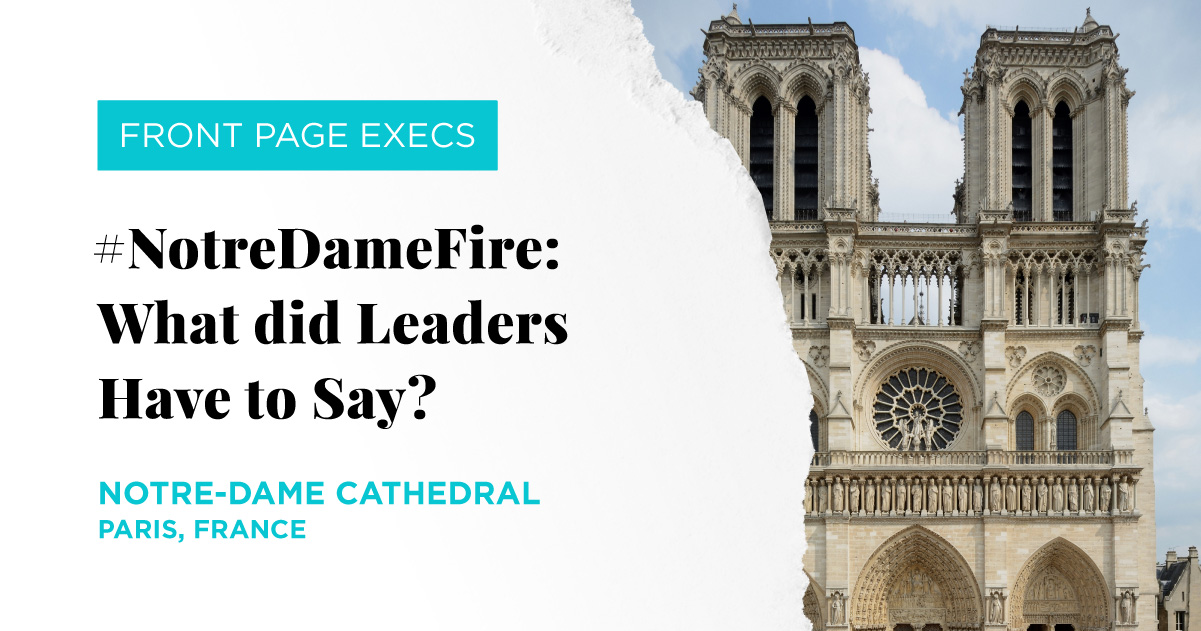On April 15, 2019, the world watched with sadness as the Notre Dame Cathedral was engulfed in flames. People turned to social media for news updates as it happened, and then afterwards to form a community of support and discussion using the hashtag #NotreDameFire.
In the midst of such an event, executives must carefully consider what to post on social media, if they decide to post anything at all, so as not to seem self-serving or that they are taking advantage of misfortune. Many CEOs and other executives chose not to post about the Notre Dame fire, which was not offensive to those affected, but also did not allow them to be demonstrative of their awareness of newsworthy events or of producing significant and timely content.
Below are three different tweets that CEOs shared. In today’s Front Page Execs by Influential Executive, we take a look at the various reactions from these influential executives and how each one handled the situation a little bit differently.
Help with the Notre Dame reconstruction in one of these fundshttps://t.co/LWjLOGPt9v https://t.co/jLXWDv04oy
— Eric Schmidt (@ericschmidt) April 17, 2019
Eric Schmidt, the former CEO of Google, posted this tweet the day after the Notre Dame Fire. Schmidt shared Quest Means Business’s tweet, which includes an interview that he did with CNN about the fire, as well as a link directing users to a page where they can donate money to the rebuilding cause.
Both the tweet and the link effectively demonstrate his position regarding the Notre Dame fire. However, the copy may be confusing to some readers. Schmidt does not reference his interview at all, and it is easy to miss that he was featured at all if a user clicks on the link instead of the link card, as they do not lead to the same site.
Additionally, his tweet misses an opportunity to express his condolences, only stating that funds are available for people who wish to donate. Although his interview clearly expresses his sympathetic outlook on the Notre Dame fire and his desire to help rebuild it, the same sympathy is not apparent in the tweet itself.
To improve the copy in his tweet, we would recommend that Eric Schmidt share his feelings surrounding the fire, specifically reference his interview, and state what the separate link leads to. With these small improvements, Schmidt’s response to the Notre Dame fire would appear more human and genuine, and less confusing to the reader. We would also suggest that he make use of the hashtag #NotreDameFire to make his post more searchable and to connect it to the larger community of users discussing the fire.
We’re all sickened by the fiery destruction of Notre Dame, an irreplaceable structure that exemplified the spirit, grandeur and creativity of humanity at its best. We grieve at its loss. The world is a poorer place.
— Steve Forbes (@SteveForbesCEO) April 15, 2019
Steve Forbes, Chairman and Editor-in-Chief of Forbes Media, posted this tweet the same day as the Notre Dame Fire. He does not share any links, as Eric Schmidt did, but this post is effective due to its sympathetic and caring tone. Forbes expresses that he is “sickened” by the destruction by the Notre Dame, and goes on to describe the church as a “structure that exemplified the spirit, grandeur and creativity of humanity at its best.” These statements show his compassion and humanize him.
Additionally, Forbes made the choice to use the pronoun “we” instead of “I.” In doing so, he becomes representative of his company as a whole, and the humanizing and genuine post reflects on it. By using “we,” Forbes also becomes more personally connected to the reader, which supports the authentic tone of his tweet. In order to make Forbes’s post even more effective, we would suggest altering the copy slightly so that it also reflects on the positivity and hope in the future. Including this mix of positivity with mourning would position him and his company as caring and sympathetic, but also optimistic and willing to work towards a solution to the problem. In addition, we would suggest that he, like Schmidt, make use of the hashtag #NotreDameFire.
We are heartbroken for the French people and those around the world for whom Notre Dame is a symbol of hope. Relieved that everyone is safe. Apple will be donating to the rebuilding efforts to help restore Notre Dame’s precious heritage for future generations.🇫🇷
— Tim Cook (@tim_cook) April 16, 2019
Tim Cook, the CEO of Apple, posted this tweet the day after the Notre Dame Fire. Cook does an excellent job of expressing his sympathy for the unfortunate event, as well as his intention to be a part of the rebuilding efforts. First, he conveys how heartbroken he is for the people of France and everyone who sees the Notre Dame as “a symbol of hope.” With this, he shares his emotions as well as acknowledges the symbolism and nationality of the church. He then takes it a step further, and expresses his relief that everybody is safe. This statement makes the post more relatable, because it moves the focus from the building itself to the people who were personally affected. Finally, Cook states that Apple will be donating funds to the rebuilding effort to restore Notre Dame’s heritage. This successfully portrays his optimism and positivity, and displays his company’s charitability and activism. Cook makes the decision to use the pronoun “we,” similarly to Forbes, with the same result. The use of “we” reflects his thoughts and emotions onto his company, as well as engages the users more successfully.
Tim Cook’s tweet is very effective because it looks at Notre Dame as a powerful national symbol, expresses his emotions about the fire, and states his intention to be a part of the solution; he successfully brings the user from the past, through the present, and into the future, so they feel the full realm of emotions associated with Notre Dame burning. If we were to make suggestions about improving this tweet, we would again suggest the use of #NotreDameFire, not only to make the post more searchable, but also to connect it to the ever-growing community rallying around each other in the wake of this tragedy.
When executives make posts about current events, particularly tragedies, they must be careful and deliberate so as not to appear callous or as if they are taking advantage of a terrible event. These CEOs made the decision to post respectfully about the #NotreDameFire, and in doing so, successfully humanized themselves and their respective companies.


